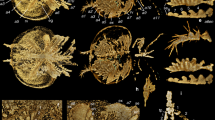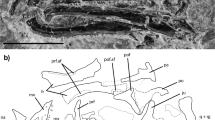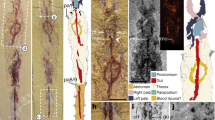Abstract
Arising from J. Liu et al. Nature 470, 526–530 (2011)10.1038/nature09704; Liu et al. reply
Liu et al.1 described an ‘armoured’ lobopodian, Diania cactiformis, from the Chengjiang Lagerstätte (China; Cambrian, stage 3); this fossil bears potentially arthropod-like articulated and possibly sclerotized appendages, but lacks a sclerotized body. A cladistic analysis resolved Diania as sister-taxon to arthropods. From this phylogenetic position the authors tentatively inferred that arthropodization (sclerotization of limbs) may have preceded arthrodization (sclerotization of body elements) in arthropod evolution. Although we concur with the reasoning behind this inference, it rests on a phylogenetic placement that our analysis of the published data set does not reproduce.
Similar content being viewed by others
Main
Our analyses were undertaken using implicit enumeration (branch and bound) in TNT (Tree Analysis using New Technology) v.1.1 (ref. 2), first repeating the analysis of Liu et al.1 with implied character weighting (k = 2) and additionally with equal character weighting; results are shown in Fig. 1b, c. In neither analysis was Diania resolved as sister-taxon to Arthropoda, instead belonging to an unresolved polytomy at the base of the resultant most-parsimonious trees. To confirm that the trees of Liu et al.1 are less parsimonious, a second pair of analyses was undertaken. Here tree topologies were constrained to the published strict-consensus topology (Fig. 1a), again using implied (k = 2) and equal weighting schemes. In both cases a single tree was found, substantially longer than those our first analyses recovered (16.4 as opposed to 12.4 steps under implied weighting; 119 as opposed to 89 steps under equal weighting). This demonstrates that the published topology is far from the most parsimonious that can be obtained from the data set. The use of a branch and bound (rather than heuristic) search indicates that this discrepancy is not a result of chance failure to hit upon the best solution; instead we believe that it reflects a methodological error in the original analysis.
a, Topology proposed by Liu et al.1 (implied weights, k = 2, 16.4 steps, consistency index (CI) = 0.336, retention index (RI) = 0.546; equal weights, 119 steps, CI = 0.336, RI = 0.546). b, Strict consensus of five most parsimonious trees using the methods of Liu et al.1 (implied weights, k = 2, 12.4 steps, CI = 0.444, RI = 0.713). c, Strict consensus of 86 trees produced with equal character weighting (89 steps, CI = 0.499, RI = 0.718). Numbers represent important characters of Liu et al.1 relating to arthropodization and arthrodization.
The phylogeny recovered here suggests a polyphyletic origin of arthropodized limbs, where the arthropodization in Diania was acquired separately to that of the crown-group arthropods. It does not rule out the ‘leg-first’ (as opposed to arthrodization-first) scenario posited by Liu et al.1, but provides no support for it either. The recovered polychotomy demonstrates that the character coverage of Liu et al.1 is inadequate to resolve the interrelationships of lobopodians; a more comprehensive data set is required to assess the position and significance of Diania properly. We note, however, that our results from the Liu et al.1 data set (Fig. 1b) place the euarthropods within the dinocaridids (radiodonts and related taxa), and as such are similar to other analyses3,4 which have used more character- and taxon-rich data sets. The origin of arthropodized trunk limbs is problematical in this topology, as dinocaridids apparently lack any form of leg-like trunk appendage5. The increasingly detailed fossil record of stem-group euarthropods provides our best chance of resolving this issue, but as yet has failed to do so; unequivocal evidence for any particular ordering of acquisition in these characters is not yet available. Diania is a fascinating animal, but in its revised position it contributes little to this debate.
References
Liu, J. et al. An armoured Cambrian lobopodian from China with arthropod-like appendages. Nature 470, 526–530 (2011)
Goloboff, P. et al. TNT, a free program for cladistic analysis. Cladistics 24, 774–786 (2008)
Daley, A. C. et al. The Burgess Shale anomalocaridid Hurdia and its significance for early euarthropod evolution. Science 323, 1597–1600 (2009)
Ma, X. et al. Morphology of Luolishania longicruris (Lower Cambrian, Chengjiang Lagerstätte, SW China) and the phylogenetic relationships within lobopodians. Arth. Struct. Dev. 38, 271–291 (2009)
Zhang, X. & Briggs, D. E. G. The nature and significance of the appendages of Opabinia from the Middle Cambrian Burgess Shale. Lethaia 40, 161–173 (2007)
Author information
Authors and Affiliations
Contributions
D.L. was responsible for writing and coordination of the manuscript; X.M., J.W., J.O.-H., G.E.D. and M.S. helped with discussion. D.L. and J.W. were also responsible for reanalysing the data. J-O.-H. produced the accompanying figure and M.S. aided with wording and stylistic editing of the original manuscript.
Corresponding author
Ethics declarations
Competing interests
Competing financial interests: declared none.
PowerPoint slides
Rights and permissions
About this article
Cite this article
Legg, D., Ma, X., Wolfe, J. et al. Lobopodian phylogeny reanalysed. Nature 476, E1 (2011). https://doi.org/10.1038/nature10267
Received:
Accepted:
Published:
Issue Date:
DOI: https://doi.org/10.1038/nature10267
This article is cited by
-
Hallucigenia’s onychophoran-like claws and the case for Tactopoda
Nature (2014)
-
Liu et al. reply
Nature (2011)
Comments
By submitting a comment you agree to abide by our Terms and Community Guidelines. If you find something abusive or that does not comply with our terms or guidelines please flag it as inappropriate.




